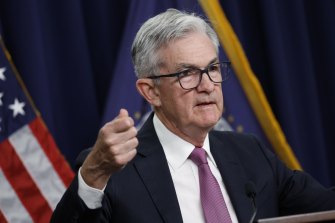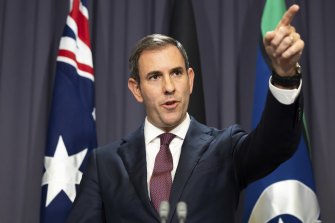New Australian treasurer Jim Chalmers has said an Australian recession is not on his list of fears for the Australian economy but the surging inflation rate, the inevitable RBA response, the potential for significant falls in house prices and the ebbing of the global economic tides will challenge his confidence.
If the US were to post two quarters of negative growth it would be a very odd recession, however technical.
Unemployment in the US is only 3.6 per cent, close to a 50-year low. Australia’s is 3.5 per cent, also the lowest in nearly half a century.
Conventionally, central bank-induced recessions in response to spikes in inflation are characterised by steeply rising unemployment as activity is choked by the higher interest rates. That may, of course, yet occur.

Jerome Powell and the Fed have belatedly ramped up the fight against inflation.Credit:Bloomberg
The spiralling of inflation rates and the slowing in global growth aren’t, however, being driven entirely by conventional influences.
There are some conventional elements.
In response to the pandemic most central banks, including the Reserve Bank, cut their policy rates to close to zero, and some below zero. They deployed unconventional policies, buying bonds and other securities to keep market rates within those previously unchartered territories. They made near-costless funds available to their banking system.
Loading
Negative real rates and torrents of liquidity were accompanied by extremely expansive fiscal policies as governments in all the major economies spent massively to offset the otherwise devastating impact of pandemic-driven lockdowns of their economies.
The ultra-loose monetary and fiscal policies were, once the worst of the pandemic’s fallout had peaked, always going to have an impact on inflation and subsequently on interest rates, forcing the normalisation of those policies.
That’s, broadly, the historic recipe for outbreaks of inflation and the central banks’ responses to them – loose monetary and/or fiscal policies ignite demand and inflation and central banks respond by raising interest rates and withdrawing liquidity to drive down demand.
There are, however, some peculiarities to the current global breakout of inflation that make it a bit different to previous episodes and which complicate the responses of the central banks and their governments.
With hindsight, the central banks and governments were too slow to recognise that some of the pandemic-related influences that sparked the surges in inflation – most notably the disruption it caused within global supply chains – were less than transitory. They started tightening well after rising inflation rates had become entrenched.

Australian treasurer Jim Chalmers has said an Australian recession is not on his list of fears but a range of headwinds will challenge his confidence.Credit:Alex Ellinghausen
Some of those supply chain disruptions persist and some might actually be structural. Governments and companies saw vulnerabilities within their economies and business models exposed by the pandemic.
Decades of accepted wisdoms about the benefits of globalisation, “just in time” global sourcing and lean inventories have been challenged by the experience of the pandemic and, along with the more fractious and less trusting relationship between the West and China, are forcing supply chains to be redesigned, with significant “re-shoring” of critical activities, and inventory levels to be increased.
It’s not just the supply chain issues that are driving inflation rates to levels that could induce the global “recession we had to have” (to borrow from Paul Keating).
Russia’s invasion of Ukraine has driven energy prices to stratospheric levels in Europe and elsewhere and is also causing shortages and price hikes in other commodities, including agricultural commodities and the fertilisers that support agricultural productivity.
With hindsight, the central banks and governments were too slow to recognise that some of the pandemic-related influences that sparked the surges in inflation were less than transitory.
China, which has driven much of the global growth in recent decades, has an economy that is flat-lining and spluttering because its less-than-effective “zero COVID” policy keeps shutting down key economic zones even as it is experiencing a property sector crisis that strikes at the heart of its economy.
Increasingly violent weather events around the world – heatwaves in Europe; heatwaves and floods in China; hurricanes, blizzards and floods in the US and the recent spate of floods in Australia are also having an impact on economies and on food prices.
The current circumstances meet any definition of a perfect storm and represent a near-unprecedented set of challenges for policymakers.
Loading
Previous inflationary episodes were driven by demand out-stripping supply, forcing prices up. This time it is supply-side issues that are at the heart of the outbreaks.
Central banks still don’t know how much of what has occurred is transitory (even if the transition is protracted) and how much is structural. They don’t know how lasting the continuing outbreaks and continued evolution of COVID will be. They don’t know how long the war in Ukraine that is producing severe economic fallout will last or what its course and impacts might be.
Unable to do much, if anything, about the supply shortfalls, they are trying to lower demand to match that reduced supply.
In the circumstances, it will be more luck – a lot of luck, given how crude the tools available to them are – than good management if central banks and their governments are able to engineer soft landings and avoid recessions, whether technical or more substantive and far more painful.
The Business Briefing newsletter delivers major stories, exclusive coverage and expert opinion. Sign up to get it every weekday morning.
Stay connected with us on social media platform for instant update click here to join our Twitter, & Facebook
We are now on Telegram. Click here to join our channel (@TechiUpdate) and stay updated with the latest Technology headlines.
For all the latest Business News Click Here
For the latest news and updates, follow us on Google News.
